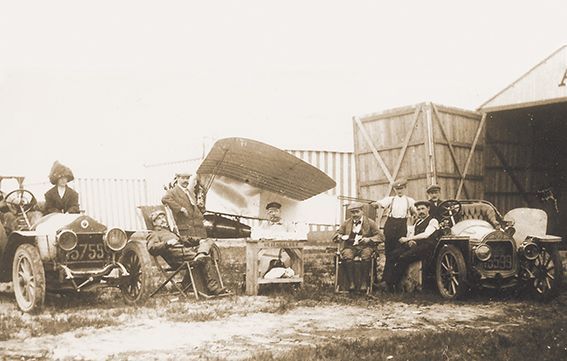
Jan Olieslagers, coffee cup in hand and his 'crew' at Sint-Job airport. (coll. Frans Mielants)
The “golden period” of the pioneers (1910-1914)
After the flying week of Antwerp in 1909, several more would follow. The whole of Europe was under the spell of the flying people. Brussels, Champagne, Rouen, Berlin, the Netherlands, the Middle and Far East, our pioneers showed their skills everywhere.
After all, there was a lot of money to be made with this daredevilry. Although sometimes things went wrong and they lost their lives.
The ladies didn't go unnoticed either...
In the years before World War I, flying continued to amaze the public. This new sport was mainly dominated by people who liked to take risks and had the financial means to do so.
Pierre Baron de Caters from Antwerp mainly flew in Germany, but was also the first to fly in Turkey and Egypt and travelled to the Dutch East Indies together with Jules Tyck. He eventually became a distributor of the German 'Aviator' aircraft. The Bollekens brothers would build these machines under license and release them under their own name: the Jero.
Jan Olieslagers kept it closer to home (France, Italy) and, together with his brother Max, caused a furore especially in the Netherlands (or how the 'flying Dutchman' was actually a Belgian...)
Jan was also the first to fly on the African continent where he raced against the local steam train in Oran, flew into telegraph wires and crashed. His plane burned out completely. Jan was left with only a few scratches and a scorched moustache.
Closer to home, the first international meeting for seaplanes was held in Temse in 1912, but flying meetings were also organised at 'Sint-Anneke' and in Sint-Job-in-'t-Goor.
Gradually however, dark clouds began to appear in the European political landscape. When war broke out in 1914, our airmen (Pierre de Caters, Jan and Max Olieslagers, Jules Tyck,...) put themselves and their aircraft at the disposal of the military authorities. Very slowly, the military became aware of the possibilities that the aircraft had to offer them...
Photo captions (top-left to bottom-right)
- Hélène Dutrieu was one of the first female pioneers. With her Farman biplane she improved the flying record for women of the French Marvingt by covering a distance of 60 km and 800 m above the air camp of 'La Beauce' in 1 hour and 9 minutes. (coll. Dirk Buytaert)
- Posing for the photographer on duty: friends for life: Jan Olieslagers (l) and Jules Tyck (r). (coll. Dirk Buytaert)
- Olieslagers also gave demonstrations on the beach at Ostend. (coll. Frans Mielants)
- Pierre baron de Caters and Jules Tyck at the official reception by the Maharaja of Misore on February 2, 1911. (coll. Dirk Buytaert)
- It also often went wrong: fatal for some, others came away with a fright and some scratches. Crash of Max Olieslagers in Leeuwarden in 1911. (coll. Dirk Buytaert)
Stampe en Vertongen Museum vzw
Antwerp International Airport
Bus 3
B-2100 Antwerp-Deurne
Belgium
O.N. BE0447.236.613
RPR Antwerp
email: stampe@skynet.be
www.stampe.be
Opening hours individual visits
- Mon - Fri
- Closed
- Sat - Sun
- -
Closed on Easter Sunday and during August, December and January
Useful links
All rights reserved | Stampe en Vertongen Museum vzw






